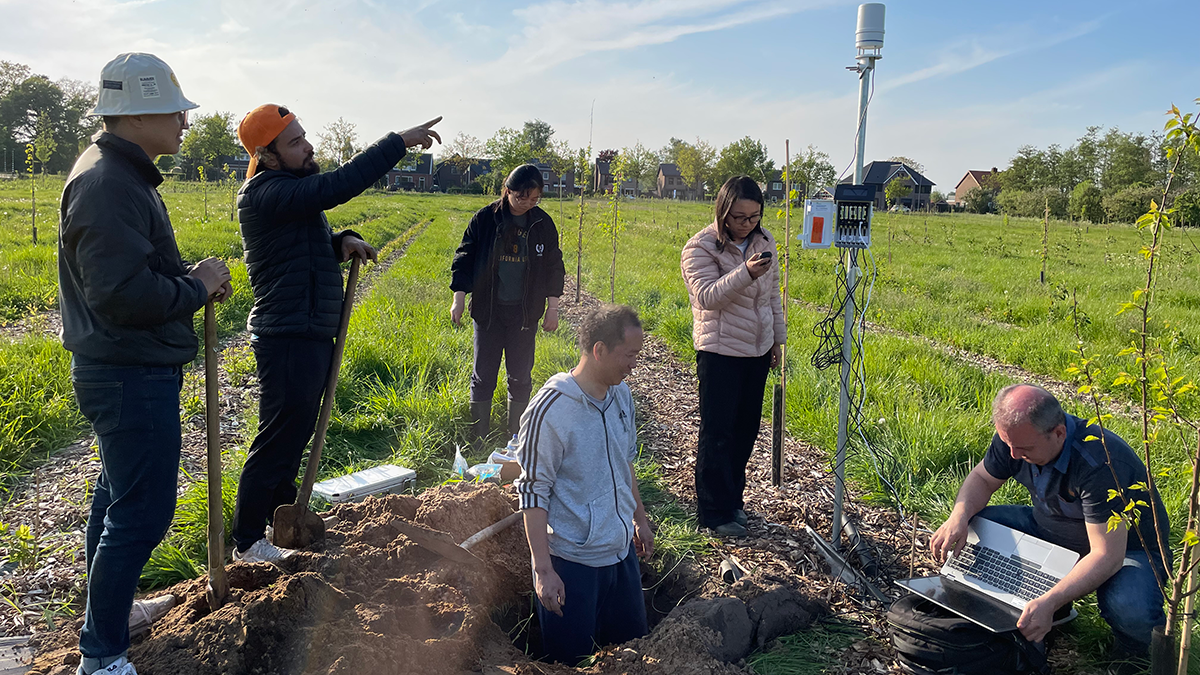Editors’ Vox is a blog from AGU’s Publications Department.
Healthy soils are vital for sustaining life on Earth. They are essential for ecosystems, agricultural production, and clean water, and even help to regulate climate.
A new article in Reviews of Geophysics explores the latest scientific methods for monitoring soil health, including innovative tools like digital twins and satellite-enabled programs, while highlighting persistent gaps in linking indicators to soil functions across scales. Here, we asked the authors to give an overview of the topic.
What is soil health, and how is it different from soil quality?
A healthy soil is a thriving ecosystem: it feeds plants, filters water, stores carbon, and supports worms, microbes, and other tiny lifeforms.
Think of soil health as the soil’s ability to “stay alive” and do its job. A healthy soil is a thriving ecosystem: it feeds plants, filters water, stores carbon, and supports worms, microbes, and other tiny lifeforms. Soil quality, on the other hand, usually refers to how good soil is for growing crops. Soil health is the bigger picture—it’s about keeping soil thriving not just for farms, but for nature and our planet.
Why does soil health matter?
Healthy soil is a multifunctional linchpin of terrestrial ecosystems. It secures food production by nurturing crops, acts as a natural water filter by retaining pollutants, and serves as a massive carbon sink, sequestering atmospheric CO₂ to mitigate climate change—a process monitored at continental scale through EU’s initiatives such as LUCAS, which tracks soil carbon through satellite and field data. Simultaneously, it harbors diverse subterranean communities, from bacteria to earthworms, that drive nutrient cycling and enhance ecosystem resilience against droughts, floods, and pathogens.
How do we measure soil health?
Scientists assess three core dimensions:
- Physical properties: Structure (e.g., root penetration, water retention).
- Chemical properties: Nutrient availability and pH balance.
- Biological properties: Microbial and macrofaunal activity (e.g., decomposition rates).
Emerging tools, such as satellite spectral imaging and AI-driven digital twins, integrate landscape-scale data (e.g., erosion patterns, vegetation cover) to contextualize field measurements. However, challenges persist in scaling microscale processes (e.g., nutrient cycling) to predict landscape-level outcomes.
Why are soil microbes so important?
Soil microbial communities (bacteria, fungi, archaea) are indispensable biogeochemical agents. They decompose organic matter, recycle nutrients, and secrete substances that stabilize soil aggregates, reducing erosion. Microbial communities also suppress plant pathogens and form symbiotic relationships with roots, enhancing crop resilience. Their absence leads to soil degradation, compromising biophysical integrity and triggering cascading declines in ecosystem functionality.
How does water affect soil health?
Water is the lifeblood of soil ecosystems.
Water is the lifeblood of soil ecosystems. Optimal moisture sustains plant hydration and microbial activity. Excess water, however, induces hypoxia, impairing root respiration and promoting anaerobic processes like methanogenesis. Prolonged drought destabilizes soil structure, increasing erosion risks. Healthy soils counteract these extremes through stable aggregates and organic matter, acting like sponges to store water during droughts and absorb rainfall during floods.
Can satellites truly monitor soil health?
Yes. Programs like the EU’s LUCAS integrate satellite data (e.g., Copernicus Sentinel-2’s multispectral imaging for organic carbon) with ground surveys—more than 100,000 soil samples collected between 2009 and 2022 for physical, chemical, and biological analysis. This hybrid approach identifies degraded zones, evaluates restoration efforts, and scales localized data (e.g., nutrient cycles) to landscape processes. These datasets also feed into digital twins, enabling predictive models that inform policies like the EU Soil Monitoring Law.
What’s a “digital twin” for the soil-plant system?
A digital twin is a dynamic, computer-based replica of a physical system – in this case, the soil-plant-environment continuum. It simulates critical processes like water, nutrient, and energy flows (e.g., using models like STEMMUS-SCOPE) and continuously improves its accuracy by assimilating real-time sensor data. This creates a virtual laboratory where we can test responses to challenges like drought or pollution without risking real ecosystems. While the concept originated in aerospace, digital twins now drive major initiatives like the EU’s Destination Earth for modeling climate extremes. Leveraging recent advances in AI and satellite data, we can now perform continent-scale soil health monitoring and scenario modeling, optimizing and transforming land management practices.
What critical gaps remain in our understanding of soil health?
Safeguarding soil health is not just an ecological imperative but a cornerstone of humanity’s future.
Key unknowns include feedback loops between soil structure and microbial communities, scaling microscale processes (e.g., nutrient cycling) to landscapes, and predicting climate impacts on soil carbon and microbial symbioses. Practical hurdles include fragmented global datasets, limited integration of microbial traits in models, and cost-effective tools for farmers. Collaborative platforms like the EU Soil Observatory bridge research and policy, but challenges like modeling root-water-nutrient dynamics in heterogeneous soils or fusing satellite-ground data persist. Addressing these gaps requires interdisciplinary innovation—an urgent task, as safeguarding soil health is not just an ecological imperative but a cornerstone of humanity’s future.
—Yijian Zeng ([email protected], ![]() 0000-0002-2166-5314), University of Twente, Enschede, The Netherlands; and Bob Su (
0000-0002-2166-5314), University of Twente, Enschede, The Netherlands; and Bob Su (![]() 0000-0003-2096-1733), University of Twente, Enschede, The Netherlands
0000-0003-2096-1733), University of Twente, Enschede, The Netherlands
Editor’s Note: It is the policy of AGU Publications to invite the authors of articles published in Reviews of Geophysics to write a summary for Eos Editors’ Vox.

